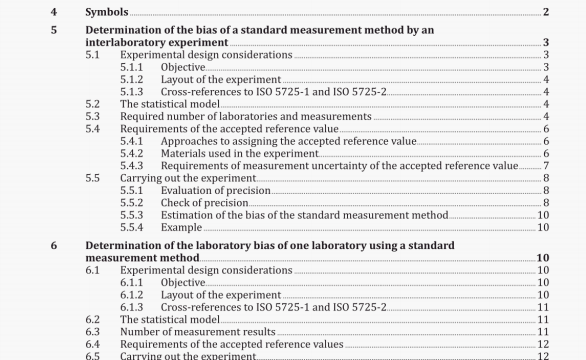ISO 5725-4 pdf download – Accuracy (trueness and precision) ofmeasurement methods and results—Part 4: Basic methods for the determination of the trueness of a standard measurement method.
5.4.2.3 The material should have a matrix as close as possible to that to be subjected to the standard measurement method, e.g. carbon in coal or carbon In steel.
5.4.2.4 The quantity of the materials shall be sufficient for the entire experimental programme. including some In reserve if this is considered necessary such as for contingencies in transportation and potential remeasurernents.
5.4.2.5 Wherever possible, the materials should have stable property values throughout the experiment. In the case of unstable materials, special instructions on transportation, storage and/or treatment shall be specified, so that the requirements in 5A3 can be achieved.
5.4.2.6 Where subdivision of the unit of the material occurs prior to distribution, It shall be performed with care to avoid the introduction of any additional error. Relevant International Standards and other documents on sample division should be consulted. The units shall be selected on a random basis for distribution. If the measurement process Is non-destructive, It Is possible to give all the laboratories In the interlaboratory experiment the same unit of the material, but this can extend the timeframe of the experiment.
5.4.2.7 In principle, the material should be adequately homogeneous, i.e. it should have an acceptable level of heterogeneity. When a material has to be homogenized, this shall be done In the manner most appropriate for that material. When the material to be measured is not sufficiently homogeneous, it is important to prepare the samples In the manner specified in the method, preferably starting with one batch of commercial material for each level of the property value. In particular, the known samples prepared by mixing materials with different known levels of property values in specified proportions. or by spiking a specified proportion of a substance to a matrix material, shall be quantified for their homogeneity, so that the requirements in 5,L3 can be achieved.
5.4.3 Requirements of measurement uncertainty of the accepted reference value
5.4.3.1 The standard measurement uncertainty of the accepted reference value, cited or derived from that In relevant documents accompanying the material or estimated for this experiment, shall be controlled to be as low as possible. If it is lower than the effect of the accepted reference value on the measLirement uncertainty of the estimate of the bias may be neglected. If it is higher than Axx5. two strategies should be considered:
— increasing p or both p and n, so that the value of A is reduced to such a level that the predetermined value of bias can be detected with a high probability;
— choosing other materials which carry an accepted reference value meeting this requirement.
5.4.3.2 The standard measurement uncertainty of the accepted reference value consists of, In principle, components arising from characterization (or calibration, or preparation) procedures, heterogeneity and instability and the measurement uncertainty arising from bias. However, for historical reasons, sometimes the uncertainties arising from hetemgeneit instability and/or bias were not included (maybe separately stated) in the certificate of reference material or measurement standard. They should be estimated by additional studies (or combined with the stated measurement uncertainty), unless there is reliable evidence that they are negligible.
5.4.3.3 Contribution of the heterogeneity to the measurement uncertainty can depend on the mass or volume used in the measurement. If the heterogeneity measurement uncertainty is the dominant component of the measurement uncertainty of the accepted reference value, the mass or volume used in the homogeneity check experiment shall be no larger than that to which the measurement method is applied. Otherwise the heterogeneity measurement uncertainty shall be re-assessed based on the latter mass or volume, and the measurement uncertainty of the accepted reference value shall be re-calculated.
5.5 Carrying out the experiment
5.5.1 Evaluation of precision
5.5.1.1 The precision experiment shall be carried out according to ISO 5725.2.
5.5.1.2 The measurement results shall be treated as described in ISO 5725-2. where the precision of the measurement method is expressed in terms of s, (estimate of the repeatability standard deviation) and 5R (estimate of the reproducibility standard deviation).
ISO 5725-4 pdf download – Accuracy (trueness and precision) ofmeasurement methods and results—Part 4: Basic methods for the determination of the trueness of a standard measurement method
